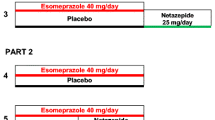Summary
Fifty out-patients with an active, endoscopically proven duodenal ulcer were entered a double-blind trial of ranitidine + prazepam or ranitidine + placebo. Two drop-outs occurred in the prazepam group and 1 in the placebo group. After 28 days of treatment, the ulcer had healed in 95.6% of the patients on ranitidine + prazepam and 75% of the patients on ranitidine + placebo (p=0.03). Sleepiness was the most frequent side effect, reported by 8 subjects in the prazepam group and by 1 subject in the placebo group. It is concluded that prazepam can be usefully combined with ranitidine in the short-term treatment of duodenal ulcer.
Similar content being viewed by others
References
Jones FA (1957) Clinical and social problems of peptic ulcer. Br Med J 1: 719–723
Hasegawa Y, Takahashi M, Ohsawa H, Kawahara H, Sato S, Sato A (1979) Psychosomatic factors as a contributory cause in the occurrence and recurrence of peptic ulcer. Jpn J Med 18: 109–114
Lyketsos G, Arapakis G, Psaras M (1982) Psychological characteristics of hypertensive and ulcer patients. J Psychosom Res 26: 255–262
Magni G, Rizzardo R, Di Mario F, Farini R, Aggio L, Naccarato R (1984) Personality and psychological factors in chronic duodenal ulcer. Their interaction with biological parameters. Arch Suisses Neurol Neurochir Psychiatr 135: 315–320
Magni G, Salmi A, Paterlini A, Merlo A (1982) Psychological distress in duodenal ulcer and acute gastroduodenitis. A controlled study. Dig Dis Sci 27: 1081–1084
Boyd EJS, Wilson JA, Wormsley KG (1983) Review of ulcer treatment: role of ranitidine. J Clin Gastroenterol 5 [Suppl 1]: 133–141
Brogden RN, Carmine AA, Heel RC, Speight TM, Avery GS (1982) Ranitidine: a review of its pharmacologic and therapeutic uses in peptic ulcer disease and other allied diseases. Drugs 24: 267–303
Somogyi A, Gugler R (1982) Drug interactions with cimetidine. Clin Pharmacokinet 7: 23–32
Greenblatt DJ, Shader RI (1978) Prazepam and lorazepam, two new benzodiazepines. N Engl J Med 299: 1342–1344
Garattini S, Marcucci F, Mussini E (1977) The metabolism and pharmacokinetics of selected benzodiazepines. In: Usdin S, Forrest DF (eds) Psychotherapeutic drugs, part III, applications. Marcel Dekker, New York, pp 1039–1087
Miller RJ, Bergeim O, Hawk PB (1920) Gastric response to foods. The influence of worry on gastric digestion. Science 52: 253–260
Wolf S, Wolff HG (1943) Human gastric function: an experimental study of man and his stomach. Oxford University Press, New York
Weiner H, Thaler M, Reiser MF, Mirsky IA (1957) Etiology of duodenal ulcer: relation of specific psychological characteristics to rate of gastric secretion (serum pepsinogen). Psychosom Med 19: 1–10
Peters MN, Richardson CT (1983) Stressful life events, acid hypersecretion and ulcer disease. Gastroenterology 84: 114–119
Magni G, Rizzardo R, Di Mario F, Farini R (1983) Gastric function and anxiety in duodenal ulcer. IRCS Med Sci 11: 1110
Birnbaum D, Karmeli F, Tefera M (1971) The effect of diazepam on human gastric secretion. Gut 12: 616–618
Leonard AS, Long D, French LA, Peter ET, Wangensteel OH (1964) Pendular pattern in gastric secretion and blood flow following hypothalamic stimulation: origin of stress ulcer. Surgery 56: 109–120
Heath RG, Mickle WA (1969) Evaluation of seven years' experience with depth electrode studies in human patients. P.B. Hoeber, New York
Brodal A (1969) Neurological anatomy in relation to clinical medicine, 2nd edn. Oxford University Press, New York
Richardson CT (1978) Effect of H2-receptor antagonists on gastric secretion and serum gastrin concentration: a review. Gastroenterology 74: 366–370
Hirschowitz BI, Hutchinson GA (1977) Kinetics of atropine inhibition of pentagastrin-stimulated H+, electrolyte, and pepsin secretion in the dog. Am J Dig Dis 22: 99–107
Hirschowitz BI, Hutchinson GA (1973) A working hypothesis for urecholine effects of hystamine stimulation on gastric secretion. Scand J Gastroenterol 8: 569–576
Johnson LR, Grossman MI (1969) Potentiation of gastric acid response in the dog. Gastroenterology 56: 687–692
Soll AH, Walsh JH (1979) Regulation of gastric acid secretion. Ann Rev Physiol 41: 35–53
Author information
Authors and Affiliations
Rights and permissions
About this article
Cite this article
Hüscher, C., Magni, G., Salmi, A. et al. Ranitidine versus ranitidine and prazepam in the short-term treatment of duodenal ulcer — a double-blind controlled trial. Eur J Clin Pharmacol 28, 177–180 (1985). https://doi.org/10.1007/BF00609688
Received:
Accepted:
Issue Date:
DOI: https://doi.org/10.1007/BF00609688




